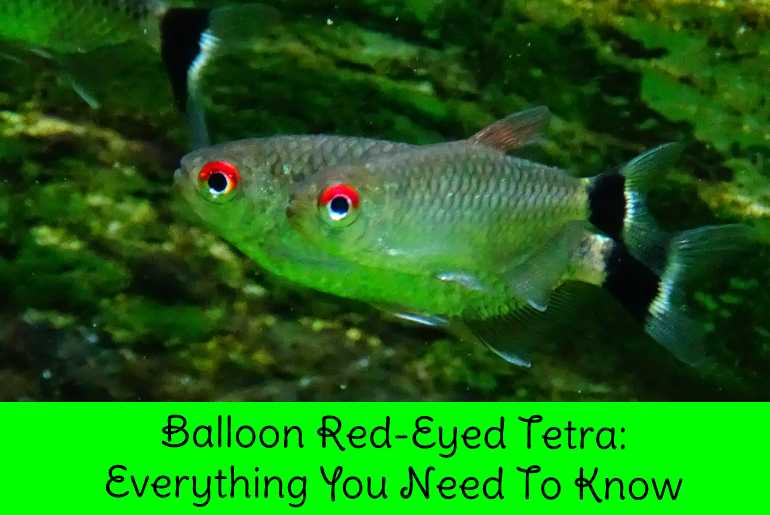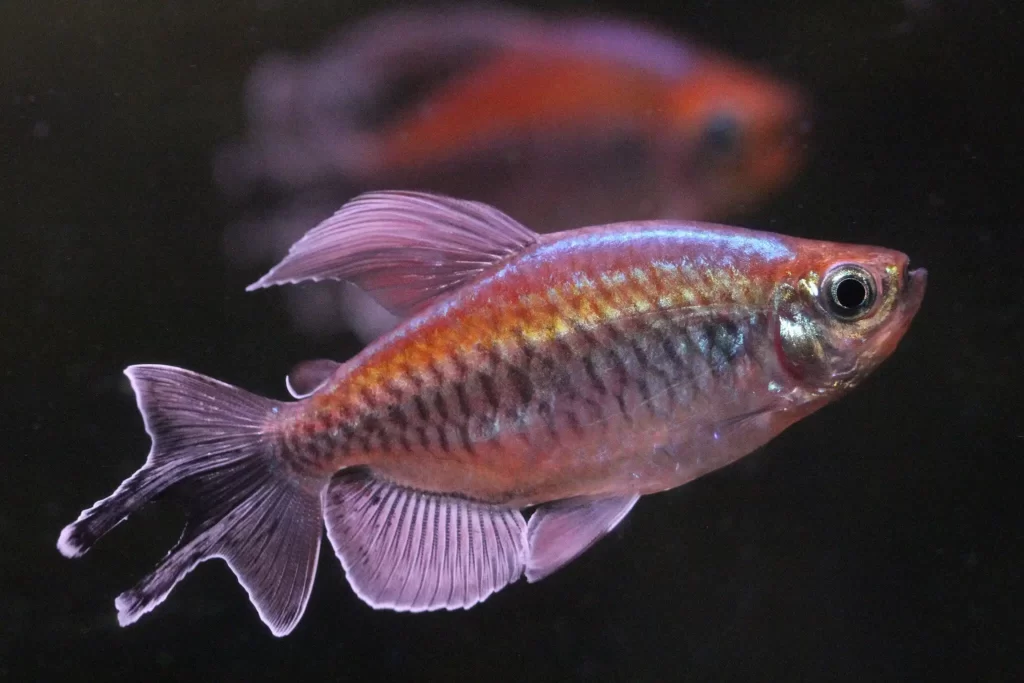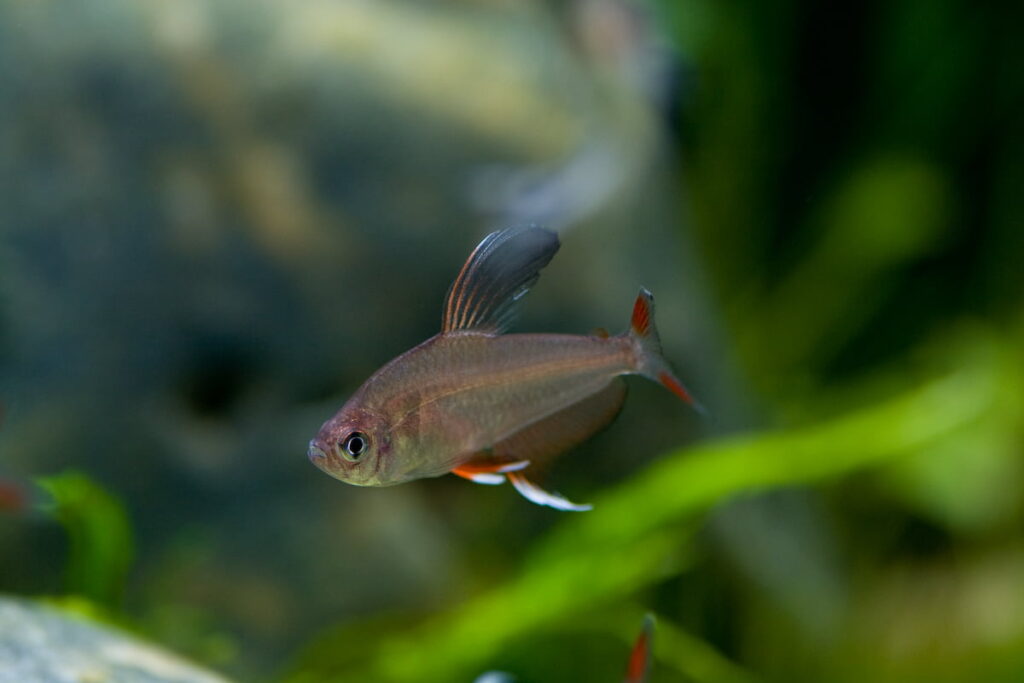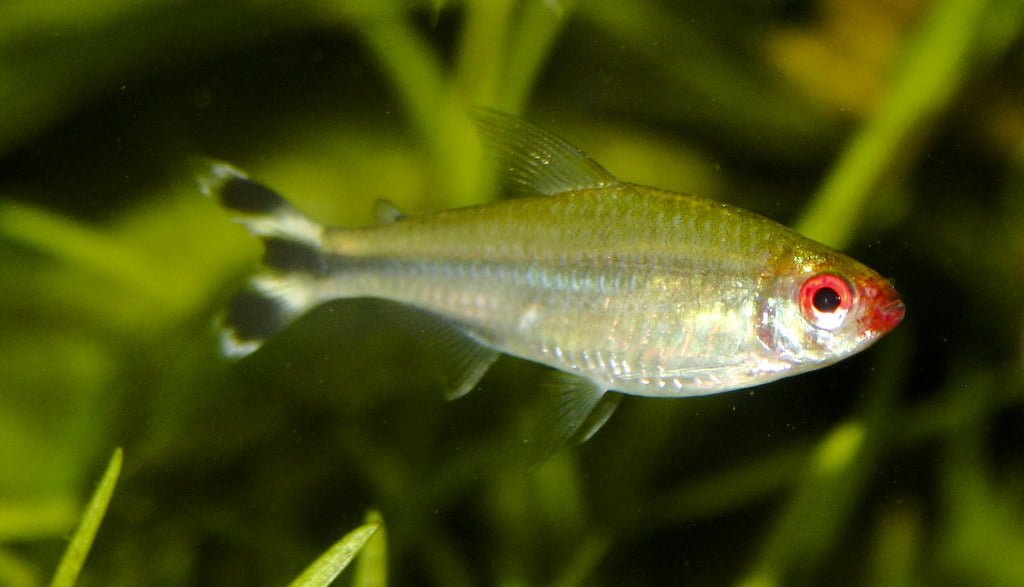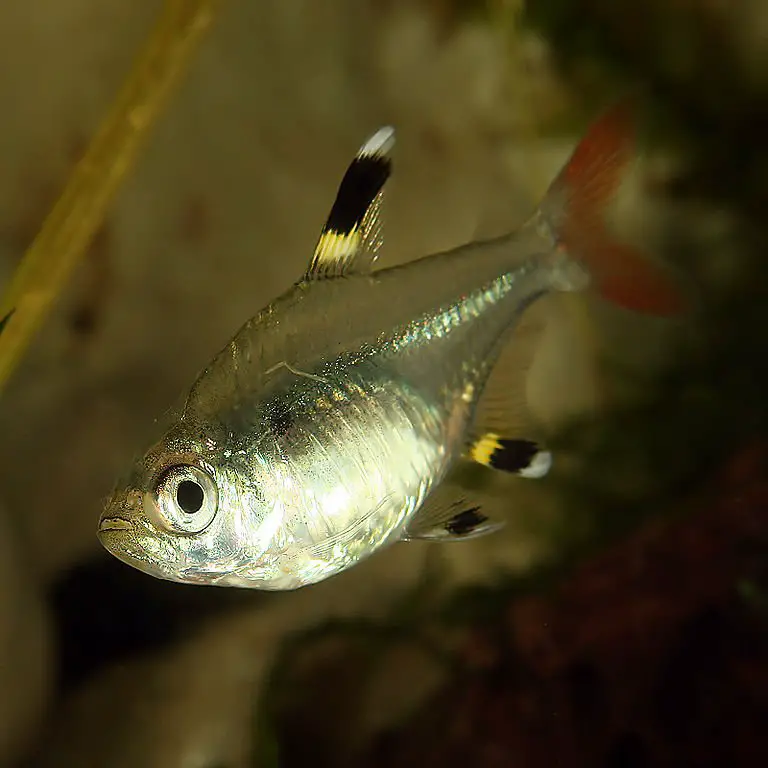If you want to add a sophisticated touch to your freshwater aquarium, believe me, Balloon Red-Eyed Tetra can be a good choice. They are peaceful, active, and love to swim in school whether six, eight, or twenty species.
Balloon Red-Eyed Tetras are named for their balloon-shaped body and distinctive red eye rim. The school of Balloon Red-Eyed Tetras can make your tank look lovely and lively. They are great for beginners in a tropical freshwater aquarium.
Moreover, due to the large size of Balloon Red-Eyed Tetras, you must house them in 20 gallons or larger aquarium.
Characteristics of Balloon Red Eyed Tetra
| Origin | South America (Brazil) |
| Family | Characidae |
| Temperament | Peaceful |
| Minimum Tank Size | 30 Gallons |
| Care Level | Easy |
| Water Conditions | 72 to 82F, KH 4 to 8, pH 5.8 to 8.5 |
| Tank Level | Mild-dweller |
| Maximum Size | 3 inches |
| Color Form | Black, Red, Silver |
| Diet | Omnivore |
| Breeding | Egg Layer |
Origin, Distribution, and Habitat
Balloon Red-Eyed Tetras are native to river basin areas of South America (Brazil). They love to live in planted tanks.
Here are the top 10 best aquarium plants that you can use in your tetra aquarium.
In the wild, they live in the flowing water of big rivers, but sometimes they swim in the tributaries in the search for food and thick plants. They are schooling fish, who feed on insects.
Are Tetras Schooling Fish? – Find out here about Easy Schooling Fish
Colors, Size, and Markings
As I mentioned prior, Balloon Red-Eyed Tetras are relatively large. The maximum size of Balloon Red-Eyed Tetras is 3 inches.
Besides, these tetras have a distinguished color pattern of black and silver that is accented with an eye-catching red marking above their eyes. So, they create an impressive display and add dynamic energy to your tank, when kept in school.
Ease of Care
Balloon Red-Eyed Tetras are social creatures, who are very easy to care for. They are not demanding fish, so good for beginners.
Learn more about Top 10 Easy to Care Tetra Fish – Perfect For Beginners.
As in the wild, there is no much light due to lots of greenery. So, it is better if you keep soft lighting in the tank which you can do by adding some fluctuant in the water like rocks, driftwoods, and plants. Also, you can create a natural habitat by providing them some hiding places.
Furthermore, the fish can jump, so you must keep them in a closed tank (more than 40 cm long), along with some areas shaded by the plant.
Balloon Red-Eyed Tetras do not like strong water flow, so you must keep the filter that does not create one. Also, every week, you much renew 20 to 25% of the water.
However, Balloon Red-Eyed Tetras have a great natural tolerance to a wide range of water parameters. Their characteristics make them well suited for a variety of aquarium setups including a community aquarium.
Learn how to Increase the pH of Your Freshwater Aquarium.
Balloon Red-Eyed Tetra Diet
The natural diet of Balloon Red-Eyed Tetras consists of small insects and planktonic animals as well. However, in your home aquarium, you can feed frozen or freeze-dried brine shrimp, daphnia, bloodworms, and tubifex. You can also treat them with micro pellet food and high-quality flake food.
The following items are the best for your balloon red-eyed tetra diet:
- Ocean Nutrition Instant Baby Brine Shrimp 0.7-Ounces (20 Grams) JarBrine shrimp
- 1000+ Live Daphnia Magna
- San Francisco Bay Brand/Sally’s Freeze-Dried Bacteria Free Tubifex – 4 oz.
- SAN FRANCISCO BAY Brand Freeze Dried Bloodworms 1.75oz
- Hikari Tropical Micro Pellets (1.58 (2 Pack))
Compatibility
As Balloon Red-Eyed Tetras are peaceful creatures, they are compatible with other peaceful fish. But, being very active, they can also scare and disturb other calm fish. So, keep them with the fish who are as active as them. E.g. Black Skirt Tetra, Emperor Tetra, Cardinal Tetra, and so on.
Also, they nip at the fins of slow-moving and long-finned fish. So, do not keep them with fish with large fins. E.g. Angelfish.
You can get additional details about ‘Are Tetras Fin Nippers? Are They Aggressive?’.
Additionally, other tetras may pick on them at times, so you must keep an eye on the community.
Looking For A Community Tank? Here Are 7 Best Serpae Tetra Tank Mates
Sex Differences
The difference between male and female Balloon Red Eyed Tetra is that male Balloon Red Eyed Tetra tends to be smaller and thinner than female Balloon Red Eyed Tetra.
Breeding the Balloon Red-Eyed Tetra
Balloon Red-Eyed Tetras become reproductive when they are 10 months old.
When you are attempting to breed Balloon Red-Eyed Tetras, set up a separate breeding tank. The tank water must be warmer (24 to 28 C), acidic (pH 6 to 8), and very soft.
Moreover, the tank must be dimly lit with clumps of spawning mops or java mops. A layer of the mesh also works fine if the space is wide enough for the eggs to pass through and, small enough for keeping the parents out. You can add a small air-powered sponge filter which will also provide gentle water flow.
You can use the following items:
- Espoma PTM8 8-Quart Organic Peat Moss
- FidgetKute 5″ Spawning Mops Camouflage 100 Strands + Suction Cups Plant Decoration Betta Show One Size
- 4 Pcs Aquarium Divider Tray Plastic Grid Aquarium Egg Crate Light Diffuser, Fish Tank Divider Filter Bottom Isolation with 8 Pcs Sucker Clip(Black)
Before Spawning
Before spawning, you must prepare the fish: keep them in a separate tank, add plant food into their diet, and feed them well for about 7 to 10 days. The fish that I kept in the breeding tank in the evening will start their breeding game in the morning.
Furthermore, the female lays up to 1000 eggs that lay on the tank bottom, or even get stuck in the plant leaves.
After Spawning
Once, the spawning has occurred, remove the mating pairs. If not removed, they can consume both eggs and hatching fries. The egg will hatch in one to two days after the pairs lay them.
Additionally, after 5 to 6 days, feed fries some fry foods like freshly hatched brine shrimp or finely crushed flake foods. Sometimes, you may find that the eggs are not hatching. Even then, you do not worry, the eggs can be unfertilized. Unfertilized eggs do not hatch.
Besides, when the babies become a few months old, you can introduce them to the adult tetras.
Nevertheless, you can spawn Balloon Red-Eyed Tetras in pairs, but for the best result, you can spawn them in a group of 12 individuals, with half of the males and half of the females.
Likewise, the articles about tetra fry you may like are:
- Tetra Fry Care – How to Care for Baby Tetras?
- Tetra Fry Tank Set-Up: Fish Tank Requirement For The Fry
- Aquarium Filters Best Suited For Tetra Fish Fry
- How To Feed Tetra Fish Fry Properly | Dos and Don’ts With Alternative Fry Food
Life Span of Balloon-Red Eyed Tetra
If the condition of the tank is perfect, Balloon Red-Eyed Tetras can live for about 2 to 5 years.
However, if the water parameter or the temperature inside the aquarium is not good enough, their life span shortens with time.
Frequently Asked Questions
Is Balloon Red-Eyed Tetra Aggressive?
Balloon Red-Eyed Tetras are very peaceful and compatible with non-aggressive fish. However, if the water condition is not right, if the temperature is against their nature, then such factors give them stress. And, stress eventually leads to aggression.
Balloon Red-Eyed Tetras are not aggressive by nature, but if things went wrong, they can act aggressively.
Can Balloon Red-Eyed Tetra Live With Guppies?
Balloon Red-Eyed Tetras are schooling tetras which must be kept in a group of at least six. They are large tetras who are not compatible with other smaller tetras and guppies.
Also, you must know, incompatible tank mates can also give stress to your Balloon Red-Eyed Tetras and they can be aggressive.
Are Balloon Red-Eyed Tetra Fin Nippers?
Balloon Red-Eyed Tetras are fin nippers but only on rare occasions. As I said earlier, Balloon Red-Eyed Tetras usually nip the fins of other slow-moving and long-finned fish.
Also, Balloon Red-Eyed Tetras must be kept in a group of six or more. If they are kept alone, then they can nip the fins of other fish.
Last Words
Balloon-Eyed tetra is the perfect tetra for your beautiful tank. It will only require a little of your effort but give a higher return to you as a pet fish. Besides, you shall take care of the water parameters and the tank setup carefully to keep these fish happy. Last but not the least, you shall keep these tetras away from small peaceful fish. Happy fishkeeping!
Related articles:
- 4 Step Process on How To Keep Tetra Fish Happy And Healthy
- Are Tetra Fish Easy to Keep and Care for?
- Water Parameters for Tetra Fish: Stable Water Condition
- Are Tetras Aggressive – List Of Aggressive Tetra Fish
- How Many Tetra Fish Per Gallon of Water?
